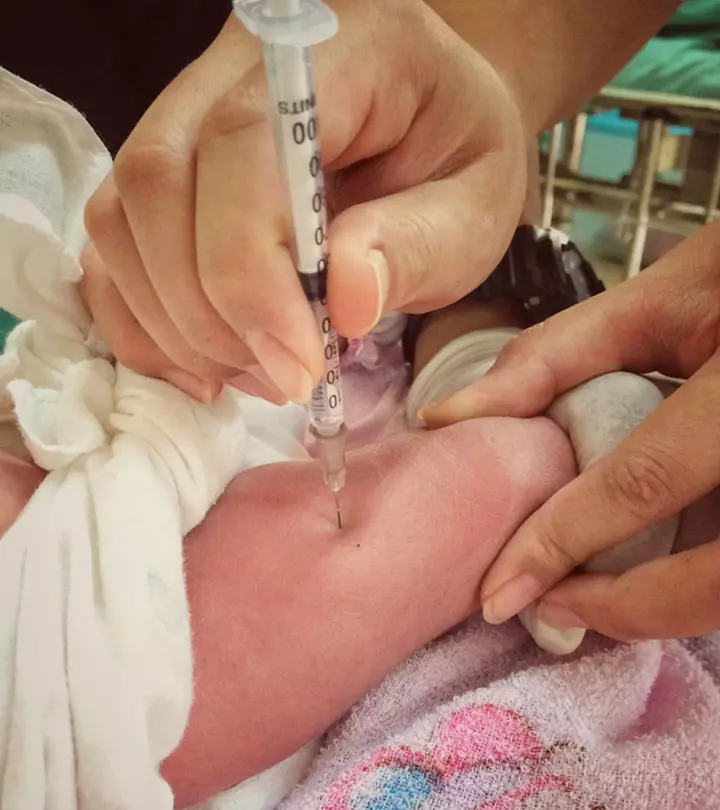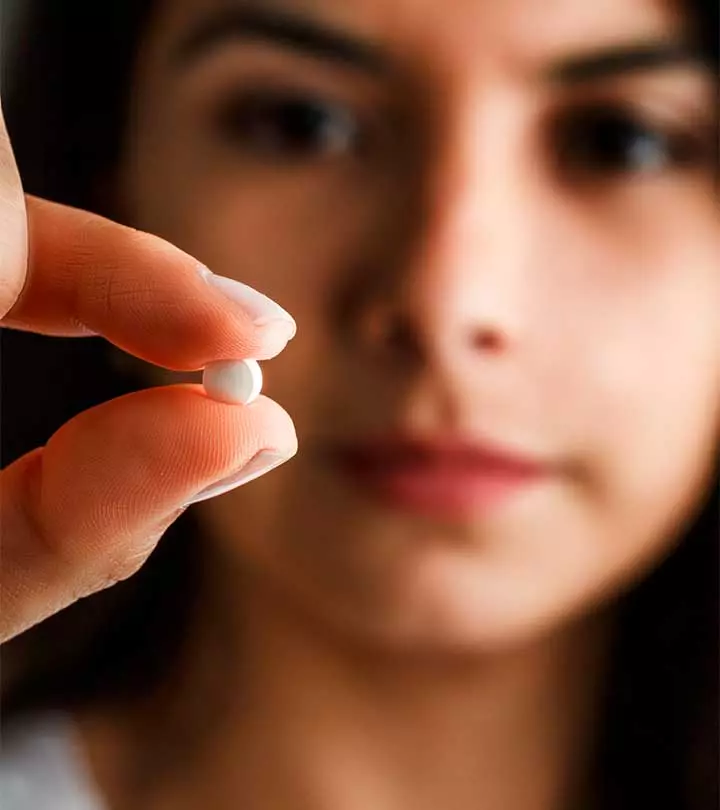
Image: ShutterStock
Feeding a baby with a syringe is an inevitable choice when a baby can’t nurse from the breast. Generally, babies are born with an innate ability to suckle and consume breast milk. However, there may be various reasons why a baby can’t do it. In such instances, feeding a baby with a syringe can help them consume breast milk. Breast milk is vital for babies as it helps them stay nourished and hydrated. Besides, it provides them antibodiesi that help against illnesses (1). Hence, syringe feeding, which enables precise control of feeding amounts, is recommended until the baby starts breastfeeding naturally. Read this post to know about syringe feeding, when it is needed, steps to feed your baby with a syringe, and precautions to observe.
Key Pointers
- Syringe feeding employs specialized infant feeding syringes to feed the mother’s milk to the baby.
- It is considered in preterm births and other conditions when the baby cannot suckle or the mother cannot nurse.
- Always use a sterile container and a separate feeding syringe to collect and administer expressed breast milk.
- After each use, flush the syringe and tubing with warm water and sterilize it.
What Is Syringe Feeding?
Syringe feeding allows the baby to consume the mother’s milk through specialized infant feeding syringes.
The breast milk is expressed into a sterile vessel and drawn into a feeding syringe. The technique is quite commonly used to feed colostrumiThe first milk produced immediately after childbirth, which is rich in immunity-providing elements , which is very low in volume, to newborns unable to breastfeed (2).
During syringe feeding, the tip of the syringe is placed on the side of the baby’s mouth to enable feeding. Some syringes have an attached fine feeding tube, which can be inserted into the baby’s mouth (3). The type of syringe used may vary depending on several factors, including the doctor’s recommendation, your baby’s health, and reasons behind the baby’s inability to breastfeed.
When Is Syringe Feeding Done?
Syringe feeding is practiced when breastfeeding is not possible because the baby cannot suckle or the mother cannot breastfeed. Elizabeth Cauvel, a mother, shares how her newborn did not latch which is why she had to choose syringe-feeding, “My baby simply declined the breast. Despite the L&D nurses’ repeated attempts, my son could not or would not latch. I hand-expressed drops of egg yolk-colored colostrum into a syringe so we could feed him (i).” Below are certain scenarios where syringe feeding may be considered (4) (5).
- Preterm babies with poor primitive reflexesiReflexes that facilitate the development of vital skills in a newborn
- Drowsy baby due to labor-inducing drugs
- Babies recovering from birth interventions
- Babies born with medical conditions or birth defects, such as cleft lipiA birth abnormality presenting as a split or opening in the lip or the roof of the mouth in babies or cleft palate
- Baby is unable to latch on the breast temporarily
- The mother is unable to feed her baby immediately
How To Feed A Newborn With A Syringe?
Below are the steps involved in feeding a baby with a syringe (2)(6)(7).
- Wash your hands with soap and water to ensure hand hygiene.
- Sit in a comfortable position. Express breast milk in a sterile container, vessel, or flask.
- Hold and wrap your baby securely while settling into a comfortable position. You may use a pillow to support the baby.

- Take a clean infant feeding syringe recommended by the doctor. Draw the milk, press the plunger to remove the air bubble, and place the syringe aside. Ensure the feeding nozzle/tip does not touch any surface.
- Use your little finger to stimulate the baby’s lips and encourage them to open their mouth.

- Put your finger inside the mouth such that the pad of the finger touches the baby’s palate (roof of the mouth). The baby will begin to suck at the finger.
- Once you sense the baby sucking at the finger, use the other hand to gently insert the syringe’s tip along the side of the baby’s mouth. Do not push it deep. The syringe should be between the gum and the cheek or between the side of the baby’s tongue and your finger.

- Gently push the plunger so that the milk flows into the baby’s mouth.
- Push the plunger again each time the baby completes a sucking motion, that is, swallows the milk. You must push no more than 0.2 milliliters of milk at a time
- Stop pushing the milk when the baby stops making the feeding/sucking motion. Resume once the baby begins. Continue feeding until the baby stops.
 Quick tip
Quick tipIn most cases, babies who are syringe-fed may be required to stay in the hospital for extra time. Therefore, the mother may find support from a midwife, nurse, or lactation consultant who can guide and assist her during syringe feeding.
Kathryn, an ardent blogger and mother, shares her experience feeding her premature son with a syringe. She says, “After Henry was born, I told the nurse I wanted to breastfeed. She said I would need to express milk until he was big and well enough to feed himself…
“They wanted me to do this initial expressing by hand, into a syringe, so not one single drop of this magic stuff would be lost down the piping of a pump…She gave me a handful of 1ml syringes. I’m not sure if you’ve seen a 1ml syringe in person, but they are tiny! She also gave me a diary—the diary was to record the time and amount of milk I had expressed. It was actually a brilliant idea because I could see how often I’d pumped, and if I was having a bad day and had missed a few sessions, it helped me stick to the 9-10 times I was recommended to pump in a day (ii).”
Tips And Precautions When Syringe Feeding
Here are some useful tips and precautions to safely syringe-feed your baby (6) (8) (9).
- Always use your little finger to open the baby’s mouth. Using another finger may cause some babies to gag.
- There are several types of infant feeding syringes with respective accoutermentsiAdditional items, accessories, or components of clothing . Most do not hold more than one milliliter of milk. Ask your pediatrician about the precise type of syringe and feeding tubes for infants you may need to feed the baby. Do not pick a syringe without consulting the doctor first.
- Make sure you decide the place and your position to hold the baby securely before you begin. It is especially necessary when you are feeding the baby alone.

- Do not place the baby flat in your lap since it may cause them to choke. Instead, place them in a partially upright position.
- Always use a sterile container to collect the expressed milk. Thaw any frozen milk before drawing it into a syringe.
- Avoid using the syringe to feed medicines since the drug may react with traces of milk inside the syringe. Maintain a separate feeding syringe to administer medicines to the baby.
- Flush the syringe and tubing with warm water after use. Clean it with soapy water and let it air dry. Thorough washing with soap and water is often sufficient to sterilize certain infant feeding syringes.
- Some syringes are only meant for a fixed number of feeds. Check it on the packaging or ask your healthcare provider about it.
- Purchase sealed infant feeding syringes and tubes that are pre-sterilized. If they are not pre-sterilized, look for information on the packaging or contact the manufacturer to learn about appropriate sterilization techniques.
- Some syringes could be dishwasher-safe. You may sterilize them in a dishwasher. If the manufacturer recommends it, you may disassemble parts of the syringe, place them in a pot of water, and boil for five minutes to sterilize it.
- Before feeding your baby expressed colostrum or milk, remove the lid from the infant feeding syringe. Keep syringes and lids out of reach of babies and children at all times.
 Be watchful
Be watchfulFrequently Asked Questions
1. Is a syringe feeding better than a bottle?
Syringe feeding could be better than bottle-feeding for preterm infants as it possesses less risk of infections. Feeding preterm infants through syringes might also avoid nipple confusioniA phenomenon where babies have trouble switching from a bottle to the breast , a common occurrence in bottle-fed preterm infants. Syringe feeding also requires more parental involvement, which might benefit the infant (10) (11).
2. Can I syringe feed formula?
The syringe feeding method is a versatile technique not just limited to delivering breast milk to babies. It can also be used to feed formula to infants. However, care must be taken so that the formula milk for your baby is dissolved when preparing and does not block the syringe nozzle.
3. What are alternative feeding techniques?
Alternative feeding techniques are used when the baby cannot consume milk directly from the breasts. These methods include syringe feeding, hand feeding, bottle feeding, cup feeding, and spoon feeding. Alternative feeding techniques are used until the baby starts to breastfeed successfully (6).
4. How long does breast milk last in a syringe?
Dr. Pierrette Mimi Poinsett, a California-based pediatrician, says, “Expressed breast milk can be stored directly in clean syringes in the coldest part of the refrigerator for 24-48 hours and in the coldest part of the freezer for up to 6 months. However, once the baby’s mouth has touched the syringe tip, any leftover breast milk should be discarded after one hour.”
5. What signs indicate that my baby may need syringe feeding?
If your baby appears lethargic, is not feeding well, or is losing weight, these may be indicators that syringe feeding may be necessary. Babies who are sleepy, have a weak suck or are unable to coordinate sucking, swallowing, and breathing may require supplemental feeding using a syringe or other feeding method to ensure they are getting adequate nutrition.
Feeding a baby with a syringe may become a necessity if they have latching issues, congenital facial abnormalities, or if the mother is not in a condition to breastfeed. This technique requires sterilized extraction equipment and syringes. It is recommended to consult a medical professional or a lactation consultant to learn the procedure of syringe feeding. They will also help you determine the right syringe feeding type for your baby. Ensure to maintain proper personal hygiene, position yourself and your baby comfortably, and start and stop feeding your baby based on their sucking reflex cues. Also, remember to clean the equipment after the feeding and replace them if needed.
Infographic: How To Tell If Your Baby Is Full During Syringe Feeding?
It is essential to follow your baby’s cues to feed them adequately through a syringe. Overfeeding or underfeeding can cause problems. Checking growth and weight gain at regular intervals is also vital to determine if the syringe feeding is going fine. Check out the infographic to learn cues that your baby is full during syringe feeding. Illustration: Momjunction Design Team
Illustration: How To Syringe Feed A Baby? 10 Steps To Follow

Image: Dalle E/MomJunction Design Team
Learn how to safely and effectively use syringe feeding tools to feed your infant. Get tips on the best tools and techniques to ensure your baby is getting the nutrition they need.
Personal Experience: Source
MomJunction articles include first-hand experiences to provide you with better insights through real-life narratives. Here are the sources of personal accounts referenced in this article.
i. Lazy eater;https://humanparts.medium.com/lazy-eater-25adad2173b8
ii. The start of my Breastfeeding journey… Daisy the Cow!.
https://mummytohenry.wordpress.com/category/breastfeeding-expressing/
References
- Breastfeeding.
https://www.who.int/health-topics/breastfeeding#tab=tab_1 - Syringe and cup feeding your baby.
https://www.blackcountry0-18.nhs.uk/application/files/2416/8794/5206/212Syringe_and_cup_feeding_your_baby_-_HT.pdf - Alternative Feeding Methods .
https://obrc.ouhsc.edu/Portals/1308a/Assets/documents/Provider_Handouts/LER-Alt.Feeding.Methods.pdf?ver=2020-06-03-094851-947 - Feeding an infant born with a cleft.
https://med.uth.edu/txcleft/blog/simple-blog-article/ - Infacts With Special Needs.
https://www.ncbi.nlm.nih.gov/books/NBK153455/#sec3_sec3.2_sess10.s4 - Alternative methods of feeding your baby: syringe, spoon, cup and bottle feeding.
https://www.uhs.nhs.uk/Media/UHS-website-2019/Patientinformation/Pregnancyandbirth/Alternative-methods-of-feeding-your-baby-3008-PIL.pdf - Guideline for Alternative Feeding Methods in the Full Term Breastfed Infant.
https://wisdom.nhs.wales/health-board-guidelines/swansea-bay-maternity-file/breast-feeding-guideline-for-alternative-methods-in-full-term-breastfed-infant-including-cup-feeding-syringe-feeding-and-bottle-feedingswansea-bay-maternity-guideline-2019pdf/ - Using a Syringe to Feed Your Child Formula or Breast Milk.
https://www.seattlechildrens.org/globalassets/documents/for-patients-and-families/pfe/pe1234.pdf - How to Clean, Sanitize, and Store Infant Feeding Items Frequently Asked Questions.
https://www.cdc.gov/hygiene/faq/index.html - Syringe and Cup Feeding a Newborn in Hospital .
https://www.mkuh.nhs.uk/wp-content/uploads/2022/10/Syringe-and-cup-feeding-a-newborn-in-hospital.pdf - Birgül Say et.al; (2019); Evaluation of Syringe Feeding Compared to Bottle Feeding for the Transition from Gavage Feeding to Oral Feeding in Preterm Infants.
https://jpedres.org/articles/evaluation-of-syringe-feeding-compared-to-bottle-feeding-for-the-transition-from-gavage-feeding-to-oral-feeding-in-preterm-infants/doi/jpr.galenos.2018.98698
Community Experiences
Join the conversation and become a part of our nurturing community! Share your stories, experiences, and insights to connect with fellow parents.
Read full bio of Dr. Dur Afshar Agha
- Dr. Pierrette Mimi Poinsett is a licensed pediatrician and a health advocate with 19 years of experience. She completed her doctor of medicine from the University of Chicago Pritzker School of Medicine and is currently practicing as a medical consultant in California.
 Dr. Pierrette Mimi Poinsett is a licensed pediatrician and a health advocate with 19 years of experience. She completed her doctor of medicine from the University of Chicago Pritzker School of Medicine and is currently practicing as a medical consultant in California.
Dr. Pierrette Mimi Poinsett is a licensed pediatrician and a health advocate with 19 years of experience. She completed her doctor of medicine from the University of Chicago Pritzker School of Medicine and is currently practicing as a medical consultant in California.
Read full bio of Rohit Garoo
Read full bio of Dr. Ritika Shah
Read full bio of Anindita Ghatak






 Point to consider
Point to consider










